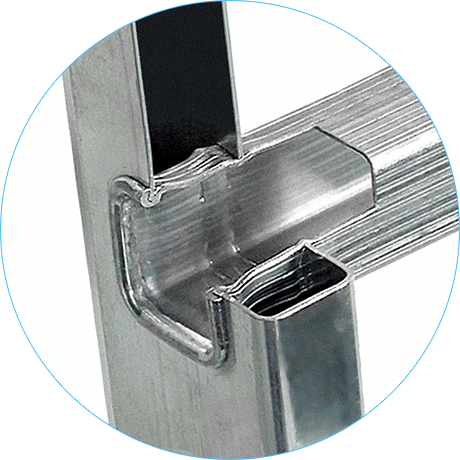First, some definitions:
Ladder (portable) is equipment designed to work at a height not exceeding, as a rule, 10 meters.
A universal staircase is a staircase that has adjustable parameters: height, type, purpose.
The ladder is a special free-standing portable ladder , tapering towards the top, having a lifting side, supporting side, platform and roll bar that folds out for a specific task and does not having adjustable parameters.
An extension ladder is a ladder that needs additional support for stability (wall, pillar and etc.).
Certain types of ladders allow work at heights up to 20 meters, however appropriateness of their use is more likely due to the required urgency or speed of the work (extreme situation: fire, rescue of people, etc.) than safety when performing such work.
Further increase in the height of the stairs is impractical due to the large weight of such stairs (more than 80 kg) that makes them non-portable.
The first image of the stairs was found in a Mesolithic cave about 10,000 years ago in the Valencia region in Spain. On the two naked people were depicted on the wall, climbing with some kind of baskets on, most likely, a grass rope ladder.

A honey picker from a hive surrounded by a swarm of bees. Spain.
There are many materials from which modern stairs were made and are made: steel, wood, hemp, flax, plastic. There are even bamboo ladders, which are widespread in countries Indochina.
With the invention of durable aluminum alloys and technologies for the manufacture of thin-walled profiles from them appeared a new type of ladders - ladders made of high-strength aluminum alloys (hereinafter, ladders are aluminum), having a number of advantages over the previously listed ones.
Aluminum is oxidized in the atmosphere quickly, but to a shallow depth. This is prevented by a protective oxide film. the thickness of which is equal to 2-3nm. Such a film has low adhesion and cannot be painted. If violated the integrity of the oxide film, then aluminum begins to corrode. The reasons for the thinning of its protective layer can be various factors, ranging from exposure to acids, alkalis and ending with mechanical damage.
Anodized aluminum is slightly more resistant to corrosion. Anodizing or anodic oxidation is a process that results in the formation of an oxide on the surface of a metal cover. An oxide film with a thickness of 1 to 200 microns (usually 20-30 microns) protects the metal surface from oxidative processes arising from the interaction of aluminum and air, has electrical insulating properties and serves as a good base for paints and varnishes. This forms a harder coating. in the form of a relatively thick porous oxide film. This improves the resistance of the metal to unfavorable external factors, and also gives a more spectacular look. However, this increases the price of the profile. by about 30%.
There are several advantages that anodizing gives:
But there are also disadvantages ..
So, anodized aluminum does not have a really high corrosion protection. In sea water as well as in places of contact with corrosive metals, corrosion occurs. Metal processing in this way also does not give powerful mechanical protection - the surface is easily scratched with an ordinary needle. Despite the fact that this The porous oxide film is not electrically conductive and should not be relied on for live work. If the technology is broken, then the coating is completely erased by hand.
But such a coating serves as a good basis for painting. It is difficult to imagine such high adhesion. If after anodizing the aluminum profile, paint it with epoxy paint, you get a very reliable coating. Epoxy paint will stay on the surface for a very long time.
This coating is even more expensive than just anodizing.
LLC "Alyumet" currently uses non-anodized aluminum in its developments, however, as well as the vast majority of Russian and foreign manufacturers.
The main advantage of modern aluminum ladders is strength and reliability with a low weight of the product and relative cheapness, which is achieved through the use of thin-walled profiles from high-strength aluminum alloys, made by extrusion (pressing) in combination with the method of joining a step and a bowstring "Unclamping" plus "rolling" (Fig. 2). The absence of welding joints and full automation of the ladder assembly process excludes the influence of the "human factor" on. the quality of stairs and gives stability to their strength properties while increasing their durability (service life) ...

Fig. 2
The disadvantages of aluminum ladders, perhaps, include their high electrical conductivity and very low heat resistance. Therefore, special care should be taken when working under voltage and apply additional means of protection for the worker, as well as to prevent contact of ladder elements with fire or high temperature environment.
Ladders, stepladders, as well as towers (platforms), according to the conditions of use, are divided into two large groups - household and professional. Household ones are intended mainly for "domestic" work, while it is assumed infrequent use of them. The maximum load is 150 kgf. Maximum ladder load the professional series is also 150 kgf, however, due to the use of a more "powerful" profile, the elastic deflection of the stairs during operation, significantly less than that of the household series, which ultimately provides more comfortable conditions for the worker. In addition, the professional series has a significantly higher safety margin. The professional series assumes constant (from morning to evening and day after day) use of stairs. It should be said that their weight is more than household ones, and, as a result, the price is higher.
By design, the stairs are divided into single-section, 2-section, 3-section and even 4-section, articulated, sliding, folding, telescopic and others. By their versatility, they are simple (for example, attached or stepladders) and universal (allowing them to be used as attachments and as free-standing stepladders).
Ladders are used in a wide variety of areas of human activity.